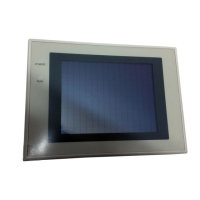9
Functions of the NT31/NT31C Section 1-2
Functions relating to the system
System menu
System settings and maintenance can be performed by selecting from system menus displayed on the screen.
Creation of screen data
Screen data created using the Support Tool at a personal computer can be transferred and stored in the built-in screen data memory.
Resume function
Screen saver function
This function serves to extend the service life of the backlight and prevent the formation of an afterimage on the screen.
Clock function
The time can be displayed in accordance with the internal clock data.
Programming Console function
Device Monitor function
System program install function
Screen display history function/alarm history function
Trend graph logging function and background function
Mathematical function
Functions relating to data input
Input by touch switches
Pop-up window function
Numeral/character string setting function
Recipe function
Several words of numeric data can be edited at the PT Unit, and written to or read from the host in one operation.
Input from a bar code reader
Data read with a bar code reader can be input to a character string input field.
Functions relating to communications
Communications with the host
This function allows calculations to be executed continuously during PT operation when mathematical table has been set in
screen data. Arithmetic operations, bit operations, logic operations, and comparison operations can be performed. Operations
with up to 5 terms are possible.
Changes in the contents of numeral memory tables displayed in trend graphs can be recorded (logging function). Also, the
record can be maintained even when the trend graph is not displayed (background function).
The screen display history function records the time at which specific screens are displayed and the number of times they
are displayed. The alarm history function records the time at which specific bits at the host are turned ON and the number
of times they are turned ON.
The system program of the NT31/NT31C can be changed by using the system installer supplied with the Support Tool
(NT-ZJ3AT1/ZJCAT-EV2). It can also be installed by using a memory unit (NT-MF261).
When the PT is connected to a PLC in a 1:1 NT Link or 1:N NT Link, the PT can be used for operations such as changing the
PLC's operating mode, displaying or changing the PVs of words, or reading the error log.
The PT can perform the same operations as a C200H-PR027-E Programming Console when the PT is connected to a CPM1,
CPM2A, CPM2C, CQM1, CQM1H, C200HX/HG/HE-(Z)E, or SRM1 PLC in a 1:1 NT Link connection, or a CS/CJ-series PLC in a
1:N NT Link connection.
The status and memory table contents of the NT31/NT31C immediately before its operation is stopped can be stored while
operation is stopped, or while the power is off, and then displayed on the screen again when operation is restarted.
The NT31/NT31C can communicate with the host by four methods: host link, 1:1 NT Link, 1:N NT link (standard or high-speed),
and Memory link. Data can be read from the host, and data input by means of touch switches and numeral/character string
settings can be sent to the host. It is also possible to connect with other model PLCs.
Numeric keys and character keys can be assigned to touch switches so that numeric values and character strings can be input at
the operation site.
The input data is written to numeral/character string memory tables and also sent to the host. It is also possible to disable input by
control from the host.
A window overlaying the currently displayed screen can be alternately opened and closed by pressing a touch switch.
In addition to fixed character and graphic displays, control keys and character keys created as touch switches can also be set
inside the window. A maximum of three windows can be displayed simultaneously. Since the window need only be opened when
input is required, the screen can be used efficiently.
Data can be input by simply touching touch switches displayed on the screen.
The possible functions of touch switches include sending data to the host and changing the screen display.
Inputs can be enabled and disabled from the host when interlock bits have been allocated.

